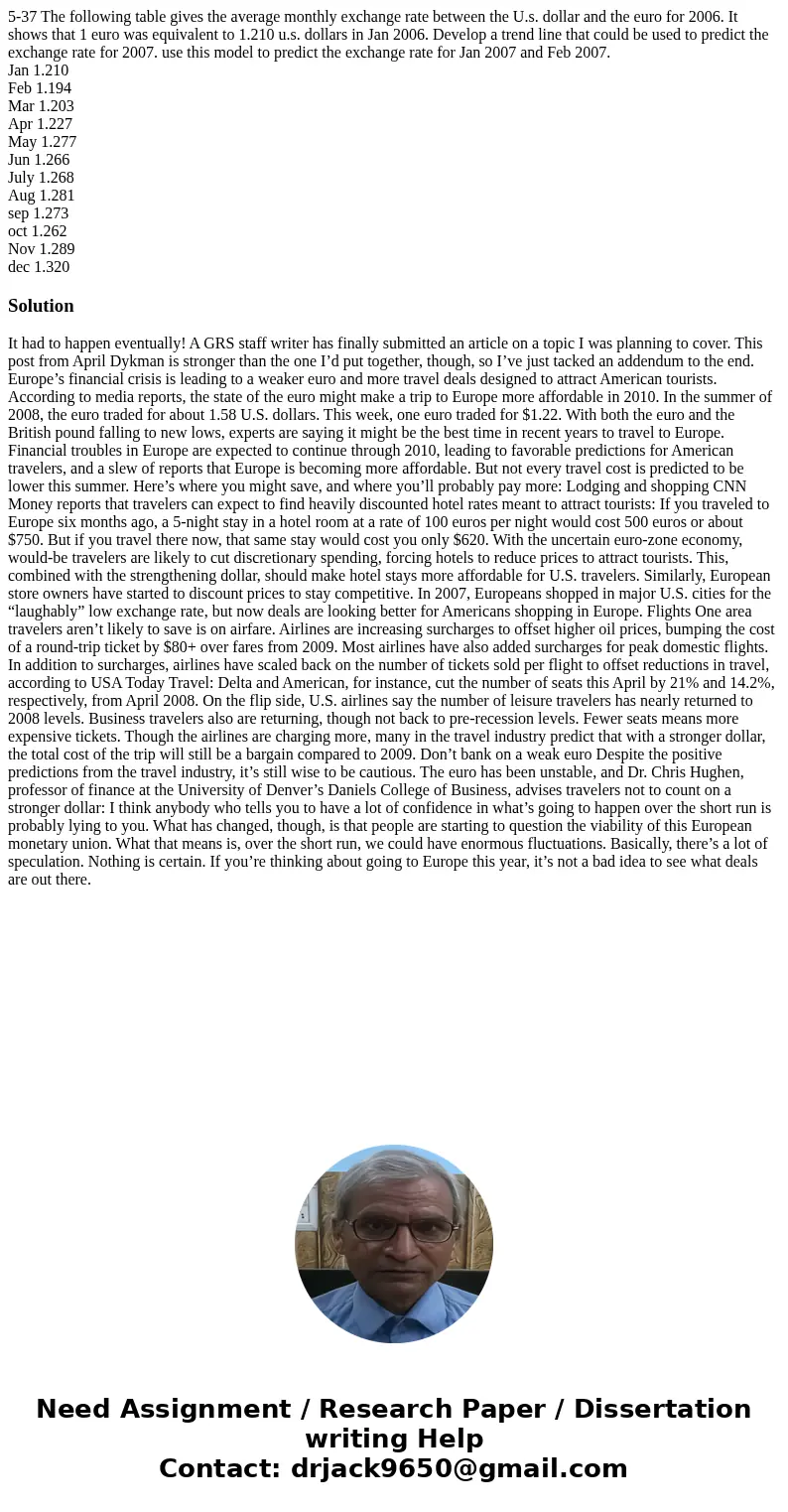537 The following table gives the average monthly exchange r
5-37 The following table gives the average monthly exchange rate between the U.s. dollar and the euro for 2006. It shows that 1 euro was equivalent to 1.210 u.s. dollars in Jan 2006. Develop a trend line that could be used to predict the exchange rate for 2007. use this model to predict the exchange rate for Jan 2007 and Feb 2007.
Jan 1.210
Feb 1.194
Mar 1.203
Apr 1.227
May 1.277
Jun 1.266
July 1.268
Aug 1.281
sep 1.273
oct 1.262
Nov 1.289
dec 1.320
Jan 1.210
Feb 1.194
Mar 1.203
Apr 1.227
May 1.277
Jun 1.266
July 1.268
Aug 1.281
sep 1.273
oct 1.262
Nov 1.289
dec 1.320
Solution
It had to happen eventually! A GRS staff writer has finally submitted an article on a topic I was planning to cover. This post from April Dykman is stronger than the one I’d put together, though, so I’ve just tacked an addendum to the end. Europe’s financial crisis is leading to a weaker euro and more travel deals designed to attract American tourists. According to media reports, the state of the euro might make a trip to Europe more affordable in 2010. In the summer of 2008, the euro traded for about 1.58 U.S. dollars. This week, one euro traded for $1.22. With both the euro and the British pound falling to new lows, experts are saying it might be the best time in recent years to travel to Europe. Financial troubles in Europe are expected to continue through 2010, leading to favorable predictions for American travelers, and a slew of reports that Europe is becoming more affordable. But not every travel cost is predicted to be lower this summer. Here’s where you might save, and where you’ll probably pay more: Lodging and shopping CNN Money reports that travelers can expect to find heavily discounted hotel rates meant to attract tourists: If you traveled to Europe six months ago, a 5-night stay in a hotel room at a rate of 100 euros per night would cost 500 euros or about $750. But if you travel there now, that same stay would cost you only $620. With the uncertain euro-zone economy, would-be travelers are likely to cut discretionary spending, forcing hotels to reduce prices to attract tourists. This, combined with the strengthening dollar, should make hotel stays more affordable for U.S. travelers. Similarly, European store owners have started to discount prices to stay competitive. In 2007, Europeans shopped in major U.S. cities for the “laughably” low exchange rate, but now deals are looking better for Americans shopping in Europe. Flights One area travelers aren’t likely to save is on airfare. Airlines are increasing surcharges to offset higher oil prices, bumping the cost of a round-trip ticket by $80+ over fares from 2009. Most airlines have also added surcharges for peak domestic flights. In addition to surcharges, airlines have scaled back on the number of tickets sold per flight to offset reductions in travel, according to USA Today Travel: Delta and American, for instance, cut the number of seats this April by 21% and 14.2%, respectively, from April 2008. On the flip side, U.S. airlines say the number of leisure travelers has nearly returned to 2008 levels. Business travelers also are returning, though not back to pre-recession levels. Fewer seats means more expensive tickets. Though the airlines are charging more, many in the travel industry predict that with a stronger dollar, the total cost of the trip will still be a bargain compared to 2009. Don’t bank on a weak euro Despite the positive predictions from the travel industry, it’s still wise to be cautious. The euro has been unstable, and Dr. Chris Hughen, professor of finance at the University of Denver’s Daniels College of Business, advises travelers not to count on a stronger dollar: I think anybody who tells you to have a lot of confidence in what’s going to happen over the short run is probably lying to you. What has changed, though, is that people are starting to question the viability of this European monetary union. What that means is, over the short run, we could have enormous fluctuations. Basically, there’s a lot of speculation. Nothing is certain. If you’re thinking about going to Europe this year, it’s not a bad idea to see what deals are out there.
 Homework Sourse
Homework Sourse